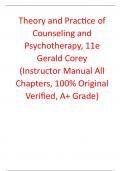Theory and Prac�ce of Counseling and Psychotherapy, 11e Gerald Corey (Instructor Manual All Chapters, 100% Original Verified, A+ Grade) Instructor Manual: Corey, Theory & Practice of Counseling & Psychotherapy, 11th ed, 9780357764428; Chapter 1: Introduction and Overview 1 © 202 4 Cengage. All Rights Reserved. May not be scanned, copied or duplicated, or posted to a publicly accessible website, in whole or in part. Instructor Manual Corey , Theory & Practice of Counseling & Psychotherapy , 11th ed, 9780357764428 ; Chapter 1: Introduction and Overview TABLE OF CONTENTS Purpose and Perspective of the Chapter ................................ ................................ .......... 2 Chapter Objectives ................................ ................................ ................................ ............. 2 Complete List of Chapter Activities and Assessments ................................ .................... 2 Chapter Outline ................................ ................................ ................................ ................... 3 Instructor Manual: Corey, Theory & Practice of Counseling & Psychotherapy, 11th ed, 9780357764428; Chapter 1: Introduction and Overview 2 © 202 4 Cengage. All Rights Reserved. May not be scanned, copied or duplicated, or posted to a publicly accessible website, in whole or in part. PURPOSE AND PERSPECTIVE OF THE CHAPTER The purpose of this chapter is to give students an introduction and overview of the Theory and Practice of Counseling and P sychotherapy textbook . First, we explain the author’s philosophical stance and suggested ways to use the textbook . Next, we differentiate between the contemporary counseling models by using the Stan and Gwen cases to identify the key issues. Finally, we describe the key themes of how each therapeutic technique present s as a demonstrat ed counseling session with Gwen. CHAPTER OBJECTI VES The following objectives are addressed in this chapter : 1. Explain the author’s philosophical stance. 2. Identify suggested ways to use this book. 3. Differentiate between each contemporary counseling model discussed in this book. 4. Identify key issues presented in the case of Stan. 5. Identify key issues presented in the case of Gwen. 6. Describe the key themes of the video counseling sessions with Gwen. [return to top] COMPLETE LIST OF CHAPTER ACTIVITIES AND ASSESSMENTS For additional guidance refer to the Teaching Online Guide. Assignments Point Value Seat Time Chapter 1 Knowledge Check 20 Points 5 minutes Chapter 1 Video Quiz: Introduction and Overview 20 Points 10 minutes Chapter 1 Helper Studio: Case of Gwen: Intake Session 30 Points 15 minutes [return to top] Instructor Manual: Corey, Theory & Practice of Counseling & Psychotherapy, 11th ed, 9780357764428; Chapter 1: Introduction and Overview 3 © 202 4 Cengage. All Rights Reserved. May not be scanned, copied or duplicated, or posted to a publicly accessible website, in whole or in part. CHAPTER OUTLINE The following outline organizes activities (including any existing discussion questions in PowerPoints or other supplements) and assessments by chapter (and therefore by topic), so that you can see how all the content relates to the topics covered in the text. I. Where I Stand (01.01, PPT Slide s 1-6) a. Author’s philosophical orientation is strongly influenced by existential approach i. Draws on various the rapy approaches ii. Uses r ole-playing techniques b. Psychoanalytic emphasis on early psychosexual and psychosocial development c. Value cognitive behavioral focus on how our thinking affects the way we feel and behave d. Exercise increasing freedom to create our own future i. Limited by social, environmental, cultural, and biological realties e. Philosophy of counseling challenges the assumption that therapy is exclusively aimed at “curing” psychological “aliments” f. As a counselor, you need to remain open to your own personal development and address any significant personal problems g. It is e ssential for a counselor to be grounded in various theories of personality and to learn how they are related to theories of counseling II. Suggestions for Using the Book (01.02, PPT Slide s 7-8) a. The personal tone of the book invites you to relate what you are reading to your own experiences b. To understand human functioning, it is imperative to account for the physical, emotional, mental, social, cultural, political, and spiritual dimensions. III. Overview of the Theory Chapters (01.03, PPT Slide s 9-10) a. Psychodynamic approaches i. Psychoanalytic therapy ii. Adlerian therapy b. Experiential and relationship -oriented therapies i. Existential therapy ii. Person -centered therapy iii. Gestalt therapy c. Cognitive behavioral approaches i. Behavior therapy




